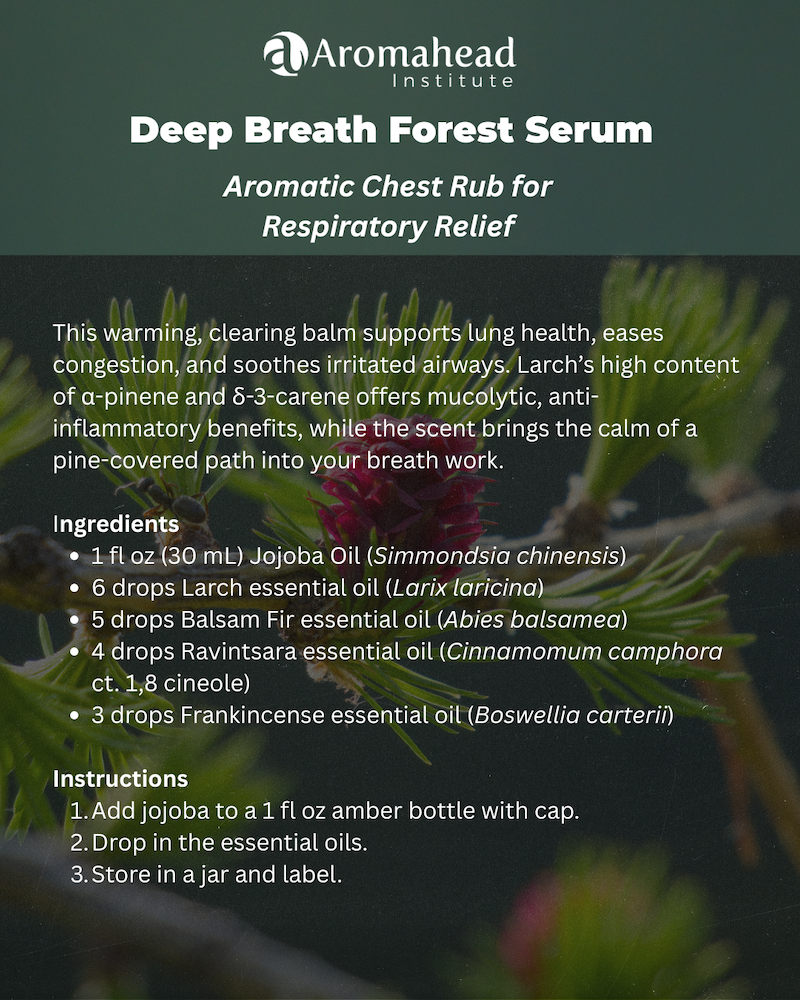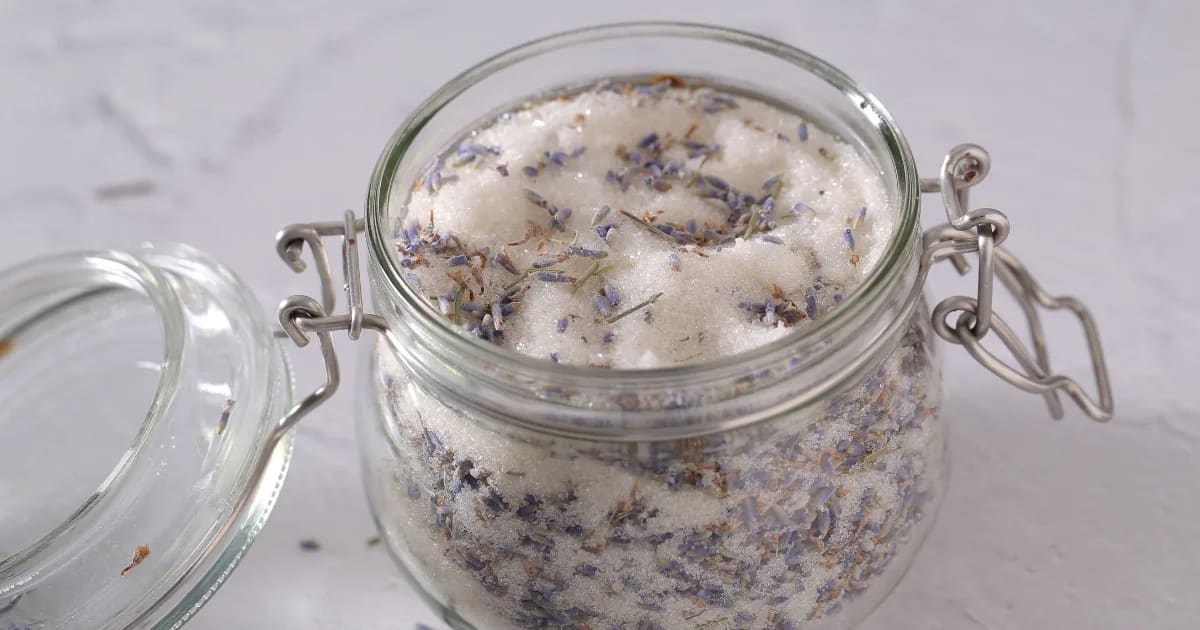Larch Profile: A Powerful Healer for Breath, Balance, and Emotional Resilience

Larch (Larix laricina), often referred to as Tamarack in some regions, is a deciduous conifer with a majestic kind of forest magic. Unlike its evergreen relatives, larch sheds its needles each fall. In spring, soft new needles emerge again that are lush, green, and touchably delicate. They stay soft through summer before turning yellow and then falling once more, echoing a rhythm of release and renewal. Distilled from the aromatic needles and twigs of trees growing wild in Eastern Canada’s boreal forests, Larch essential oil brings together therpeutic depth, subtle energetic support, and a scent that captures the essence of still woods, fresh air, and resilient life.
A Personal Connection
Its aroma feels grounding and bright all at once. Fresh and balsamic, with an earthy undertone that settles the nervous system. I often reach for it during seasonal transitions or when navigating personal change. It’s steadying and supportive without being overpowering.
In client work, I’ve used Larch essential oil in blends for those recovering from respiratory illness who are also experiencing fatigue or emotional depletion. It offers both physical and emotional support, helping the breath deepen and the body relax. In these moments, its versatility and reliability stand out.
What You’ll Learn in This Profile
The aroma and botanical background and sourcing of Larix laricina (Larch/Tamarack)
How larch essential oil supports respiratory, nervous system, and emotional health
Traditional and energetic uses rooted in observation and plant wisdom
A detailed breakdown of its chemical constituents and seasonal variability
Recipes for respiratory and emotional support, with child-safe options
Practical guidance for blending and application
Safety considerations for use, including care with asthma and sensitive individuals
Aroma: A Forest’s Embrace
The aroma of Larch essential oil is a layered experience—opening with a clean, woodsy freshness, moving into a gentle balsamic richness, and settling into a warm, resinous pine note. Slightly exotic and deeply grounding, it evokes the feeling of walking a quiet forest path where the trees have grown slow and strong, offering a sense of clarity, steadiness, and renewal with every breath.
Botanical Background Profile
Name: Larix laricina
Common Name: Larch or Tamarack
Family: Pinaceae
Plant Part: Needles and twigs
Extraction Method: Steam distilled
Origin: Eastern Canada’s boreal forest In North America, Larix laricina is often known by both names: Larch and Tamarack.
No matter the name, this tree is known for its strength, adaptability, and healing presence.
Traditional and Energetic Uses
Traditional Uses
Larch was well known among Indigenous communities in northern regions for both its healing and practical applications. Its parts were used with intention, care, and deep knowledge of the land.
Wound Care: The resin was applied to scrapes and cuts to help protect and heal.
Respiratory Relief: Teas and decoctions made from the bark or twigs were used to calm coughs and open the lungs.
Digestive Support: The inner bark was brewed to soothe the stomach.
Wood Use: The tree’s rot-resistant wood made it a valued material for building boats, snowshoes, shelters, and more.
Energetic and Emotional Uses
Larch offers lessons in resilience. It doesn’t resist change but moves with the normal cycle of nature. Energetically, it’s a reminder of the strength in letting go and the courage it takes to grow again.
Encourages confidence and self-trust
Supports emotional clarity during life transitions
Offers grounding and calm in times of uncertainty
Gently supports grief, helping release what’s ready to fall away
The Chemistry of Larch: Nature in Balance
Larch essential oil contains a rich concentration of monoterpenes. Monoterpenes are a group of compounds that contribute to both its therapeutic strength and fresh, resinous scent. What makes this oil particularly fascinating is how its composition shifts depending on the season.
GC/MS analyses show that rainfall, temperature, soil, and even the timing of harvest all affect the levels of key constituents. One batch may contain more δ-3-carene, while another sees a rise in bornyl acetate or limonene (l). These changes happen naturally, and the components work together to maintain the oil’s overall character and benefit.
Key Constituents (typical range)
α-Pinene (20–35%) – Respiratory support, anti-inflammatory
δ-3-Carene (15–25%) – Mucolytic, anti-inflammatory, supports bone and joint health
β-Pinene (9–15%) – Antimicrobial, anti-inflammatory
Limonene (l) (2–10%) – Antioxidant, supports skin health and absorption
Bornyl Acetate (4–11%) – Sedative, analgesic, supports bone health
β-Myrcene (2–10%) – Analgesic, anti-inflammatory, calming
Camphene (2–6%) – Mucolytic, antioxidant, pain relief
Terpinolene (1.5–3%) – Antioxidant, adds subtle floral-wood nuance
Therapeutic Benefits of Larch Essential Oil
Respiratory Support
High in α-pinene and δ-3-carene, larch essential oil supports lung health, clears congestion, and encourages easier breathing.
Anti-Inflammatory and Pain Relief
With bornyl acetate, β-myrcene, and camphene, this oil helps ease discomfort from muscle soreness, joint stiffness, or minor injuries.
Immune Support
The antimicrobial and antioxidant properties of β-pinene, camphene, and limonene (l) help the body stay strong, especially during seasonal shifts.
Emotional and Nervous System Support
Larch essential oil supports emotional steadiness and encourages clarity when navigating stress, self-doubt, or transition. Its calming nature makes it a helpful companion for restlessness or emotional fatigue.
Skin and Wound Care
Applied topically in dilution, Larch may help reduce inflammation, encourage skin repair, and support the healing of minor cuts or blemishes.
Bringing the Forest into Your Daily Rituals
Larch offers a unique blend of supporting our breath and gentle uplift. The recipes below are designed to help you experience its restorative qualities at home—simple, effective formulations that highlight larch’s grounding, clarifying, and supportive nature. Use them to create a sense of calm, resilience, and forest-fresh ease in your everyday wellness routine.
Two Recipes Featuring Larch Essential Oil

✧ Recipe 1: Deep Breath Forest Serum
Aromatic Chest Rub for Respiratory Relief
This warming, clearing balm supports lung health, eases congestion, and soothes irritated airways. Larch’s high content of α-pinene and δ-3-carene offers mucolytic, anti-inflammatory benefits, while the scent brings the calm of a pine-covered path into your breath work.
Ingredients
1 fl oz (30 mL) Jojoba Oil (Simmondsia chinensis)
6 drops Larch essential oil (Larix laricina)
5 drops Balsam Fir essential oil (Abies balsamea)
4 drops Ravintsara essential oil (Cinnamomum camphora ct. 1,8 cineole)
3 drops Frankincense essential oil (Boswellia carterii)
Instructions
Add jojoba the 30 ml bottle
Drop in essential oils, shake well, and cap
Massage onto the chest and back during cold season or when deep breathing is needed.
For children ages 5-10 omit the Ravintsara and add 2 drops of each of the remaining essential oil.
For a balm, melt 7 grams of beeswax and then add the jojoba oil. Once melted, drop in the essential oils.
✧ Recipe 2: Foggy Morning Inhaler Emotional Clarity + Confidence Support
This personal inhaler helps steady the heart and clear mental fog.
Supporting emotional release and self-assurance, especially during moments of self-doubt or change. The synergy of larch, sweet orange, and cedarwood offers calm strength and gentle uplift.
Ingredients
7 drops Larch essential oil (Larix laricina)
6 drops Sweet Orange essential oil (Citrus sinensis)
4 drops Atlas Cedarwood essential oil (Cedrus atlantica)
1 personal aromatherapy inhaler with a cotton wick
Instructions
Assemble the inhaler and seal.
Inhale as needed for calm, clarity, and confidence.
For children ages 5-10, add 10-12 total drops.
Safety Considerations
Larch essential oil is gentle and well-tolerated when properly diluted. There are no known safety concerns, contraindications, or reported interactions for general use. That said, I approach all respiratory work with care—especially in cases involving asthma.
While Larch can be beneficial for respiratory support, it’s always best to test the oil first. In some individuals, even gentle oils may not be suitable. Begin with low concentrations and observe the response before incorporating it more fully into a blend. As with all essential oils:
Dilute appropriately for topical use
Keep out of reach of children
Store in a cool, dark place
For children under 10, adjust total essential oil content and avoid more stimulating oils in combinations
Conclusion
Larch essential oil is like a walk in the forest. This essential oil brings both strength and grace to any apothecary. It supports the lungs, calms the nervous system, and offers steady emotional support when clarity is needed most.
Its chemistry is purposeful. Its aroma is refreshing and grounding. And its presence in blends is not overpowering. Whether in an inhaler, a serum, or a chest balm, Larch works with focus. It meets the moment with calm resolve, helping us breathe deeper, move through change, and bring a bit of the forest into everyday care.





